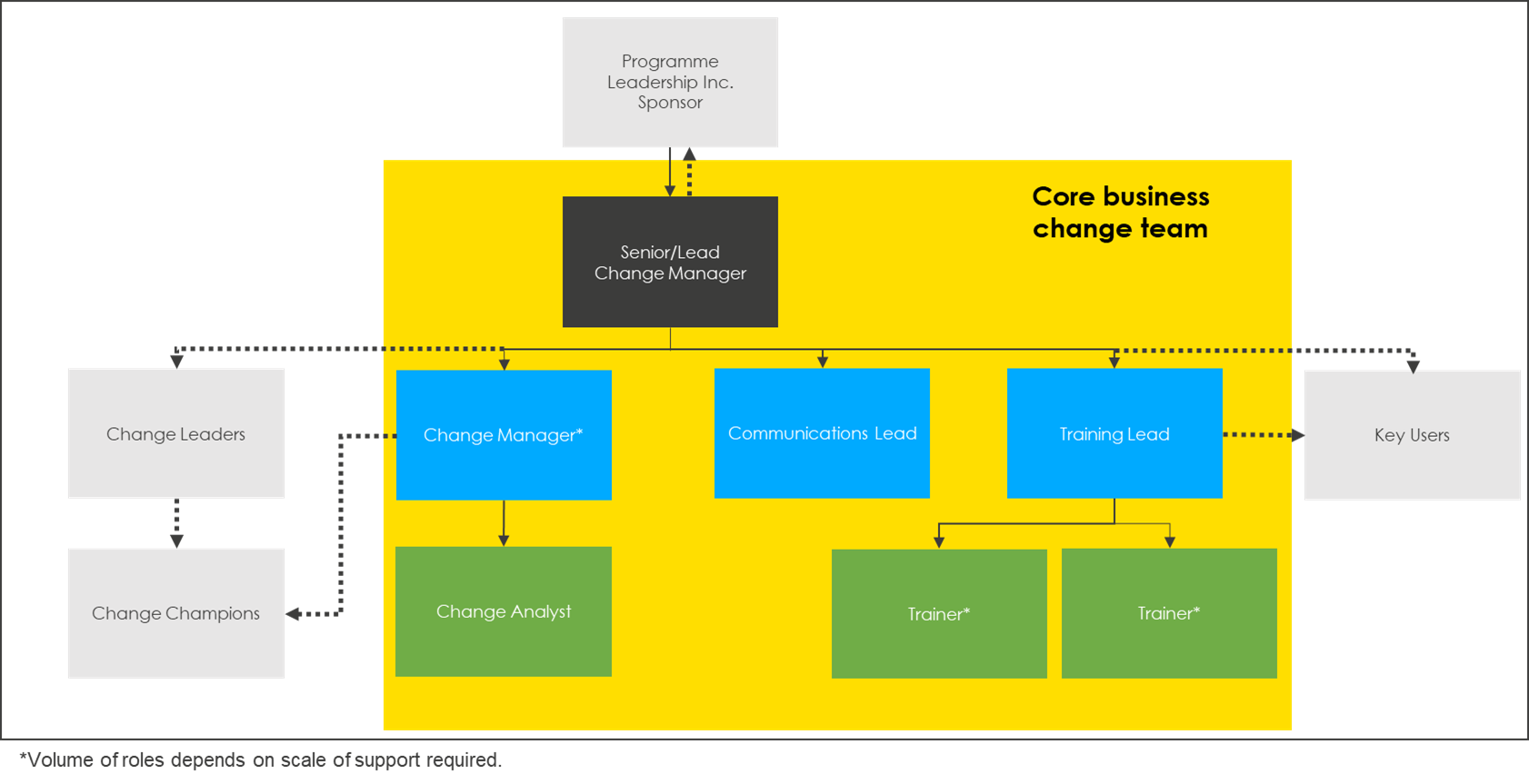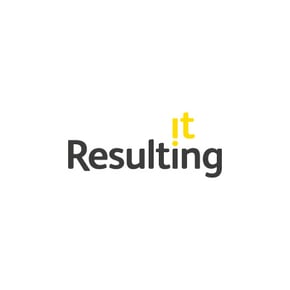Resulting have been working with our client since 2020, as a business side advisor, with the ultimate goal of developing and implementing a process framework, ERP roadmaps and creating a business case to replace their current ECC solution with SAP S/4HANA.
But, before taking on the challenge of full scale migration and implementation, Our client approached us looking for advice on how to construct the most effective change management team.
But why? Well, the client was keen to see what an independent eye would make of their current team structure, and whether they could identify any resource or skills gaps that needed to be filled ahead of the program’s initiation.
So what do we think you’ll need before you start out? Keep reading, we’ve laid it all out for you.
S/4HANA Change Structure - What’s standard and what isn’t?
Migrating to SAP S/4HANA can be scary, especially if you’re just starting out. With the ECC deadline getting ever closer, making sure you have the right bones for your change project is vital.
Below is what you could expect a typical change team structure to look like, who goes where and what they do.

Of course, depending on where you are in the planning phases and the roles you need to fill, variations will be present. What’s key is understanding who you need, where they need to be and what happens if there are gaps that need to be filled.
A bucket only works if it’s got no leaks - a model like this is easily transferable and usually only requires a few minor tweaks here and there to fit your goals and needs.
So, what should your core S/4HANA change team look like?
SAP S/4HANA Change team? Assemble.
Lead Change Manager - They should be providing overall leadership and direction for change management work within the programme. Depending on the size, scalability and complexity of the overall change, it could be that this role needs to provide strategic input into wide transformation activities and steering groups.
Change Manager - Their job? Provide targeted change support and stakeholder management. Use them to coach and facilitate the delivery of change through Change Champions (we’ll get back to them later) in the wider team.
Change Analyst - The planners, the coordinators, the analysers. These individuals analyse data in order to generate information that regular folk can understand, informing the masses on business readiness and adoption decision-making.
Communication Lead - So you can walk the walk; but can you talk the talk? Communication is essential when it comes to change. Keeping your team updated, but making sure that those updates are given at the right time to the right people. No one likes information overload, strategy and timing are key here.
Training Lead - There’s no use in all this change if you haven’t got someone to train the right people to use the systems and processes you’re looking to implement. It’s really as simple as that.
Training Developer - Of course, you can’t train people if you don’t have a training plan that suits you and your needs. Each training plan will be bespoke to you, so make sure you’ve got a variety of different learning materials and methods ready for launch. Some examples can include - webinars, e-learning courses and workshops.
Now what about support from the wider team? Look no further…
You know that niche superhero that everyone loves to see join the main team? S/4HANA change teams are no different. It’s those secondary heroes, off on their own missions, that provide the biggest assistance to the overall endgame. When it comes to SAP change, you need to look at those outside of the main team to offer support and assistance when it really matters.
Programme Sponsor - It’s time to bring out the big guns - the Directors. Support needs to come from all aspects of the organisation, but for true company-wide commitment it’s important to get senior support. They are general overseers and your assurance that the overall project isn’t getting lost in translation.
Change Leaders - So you’ve implemented the “change”, but no ones on board. Change leaders are your ticket into your work community, they’re here to ensure that these changes are filtered down and adopted by your company.
Change Champions - I told you we’d get back to them. These are your people on the ground, ready and waiting to create action plans to help their business areas transition as smoothly as possible. And, we’re not talking small scale here, we’re talking execution on a national if not global scale.
Super User - The unsung heroes of change management. These team members are familiar with your day-to-day operations within their area and, as such, are the best people to relate these changes to end-users and offer support, business representation and knowledge.
Take me to your leaders…
It’s cliche, but there’s a reason leaders are the ones sought out in any alien invasion movie. They’re the ones you want on board from the start. Whilst SAP S/4HANA and overthrowing Earth are quite different, the point still stands - leaders are the key.
According to Gartner Research, 92% of all projects they surveyed said that strong senior leadership was essential to their success.
In the case of our client their priorities were numerous, and as such they weren’t entirely sure what buy-in or support they had.
So what do we suggest? Well, baseline your sponsor and leadership team - where are they right now and where do you want them to be? It’s crucial that you determine whether any gaps exist in leadership behaviour and culture. Action plans will assist you in shaping the size and composition of your change and adoption team.
It should be obvious, but when it comes to a project the size of an S/4HANA migration, you need to be aware of your weaknesses and strengths before you start out.
Sponsors: Is there a strong call to action? Does your sponsor require coaching and direction?
Leaders: What is their disposition? Are they advocates who will actively participate? Which groups require intensive care?
With these types of evaluations and the knowledge gained, your change team can target the right support and the necessary interventions for the benefit of the overall programme.
But this isn’t a one-time thing, continuous assessment is required throughout the programme lifecycle, ultimately reducing stakeholder fatigue and prioritising focus and support for those who need it most.
Don’t be cloudy, be clear
Say, for example, you want the GPO role to be prevalent within the change structure, but you’re not sure it’ll be easy to get the commitment you need.
If you want to win the commitment of your team, you need to make it clear what participation is going to entail. You’d expect a football player to know the rules of the game, so it’s up to you to clearly document job accountabilities and responsibilities prior to forming a team. SAP change is only as easy as you make it for yourself and your team, being transparent from the start is the best way to make sure everyone is on the same page and onboard from the start.
Any resourcing, whether required or voluntary, will need to be supported by senior leadership, and blockers will need to be managed. It’s also likely that indicative capacity plans will need to be developed, to avoid any future conflicts that may occur. When it comes to migration and change, you need to be ready for any and all scenarios.
Structure and strategy are sisters, not strangers
Not only do responsibilities and accountability need to be clear, but so does the direction of your organisation. When building your team, you need to think about the role within that team - are they long-term or interim?
Change is inevitable, especially when it comes to SAP, but that doesn’t mean you have to change your whole organisation with one focus in mind. If in-house change capability works as part of your broader CoE, then implementing a more permanent team is the best option. But, it’s always worth considering options for what you can outsource when change is needed.
So, when it comes to roles, what do you need to consider?
Senior Change Manager - You need someone who knows the business, who knows how change will affect the business and how best to effect these changes. You need to think about a long-term functional role, leading the organisation's change strategy.
But, what other roles do you need?
Change Manager - If change is led from the top, it’s not always necessary to have that level of organisational involvement throughout, here you have the opportunity to bring in permanent insourced roles as well as interim or consultancy roles. Volumes can be flexible depending on the scale of change, so it’s good to make sure you cover all sides.
Don’t underestimate the size of the asteroid
We’ve all seen a traditional disaster movie in our time, and to avoid a similar fallout within your organisation you need to understand the scale of the impact.
Don’t go into change blindly, it’s important to understand who, what, when, where and how to scale up support, both in terms of your change team and the change network. Having a solid Process Framework is a good start, but you need to understand the full change impact across the organisation and how best to tackle it before making any decisions.
Find out how Resulting can enable SAP S/4HANA adoption in your organisation here.










